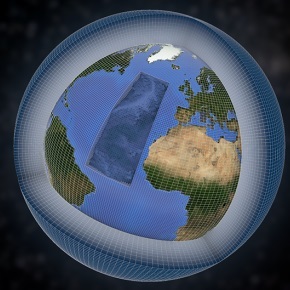Météo-France’s climate models consistently predict a pronounced global warming
The international climate science community is undertaking an extensive programme of numerical simulations of past and future climates. Its conclusions will contribute significantly to part one of the IPCC Sixth Assessment Report, which is expected to be published in 2021. The French scientists involved in the work, in particular at the CNRS, the CEA and Météo-France, were the first to submit their contributions, and they have now revealed the broad outlines of their findings. Specifically, their new supercomputer models predict that warming by 2100 will be more severe than forecast in earlier versions. They are also making progress in describing climate at the regional level.
French scientists working together in the CLIMERI-France platform participated in the World Climate Research Programme (CMIP6) using two climate models, one developed by the CNRM together with CERFACS, and the other at the IPSL. CMIP6 brings together over twenty climate centres around the world that have developed some thirty models.
Simulations with the two new French models, as well as with models from other countries that are already available, predict that by 2100 warming will be more severe than that forecast in previous versions in 2012, especially for the most pessimistic emission scenarios. This could be explained by a more pronounced climate response to the increase in human-induced greenhouse gases than in the 2012 simulations. However, the reasons for this increased sensitivity and the degree of confidence to be attributed have yet to be assessed. 
In the most pessimistic scenario (SSP5 8.5 – rapid economic growth driven by fossil fuels), the rise in mean global temperature is likely to reach 6 to 7 °C by 2100, which is 1 °C higher than in previous estimates. Only one of the socio-economic scenarios (SSP1 1.9 - marked by strong international cooperation and giving priority to sustainable development) enables temperatures to remain below the 2°C global warming target, at the cost of very significant mitigation efforts and of temporarily exceeding this target during the course of the century.
The climate models are also being used as a basis for higher-resolution climate modelling for mainland France and its overseas territories. For instance, several simulations carried out as part of CMIP6 ‘zoomed in’ on Europe and the Indian Ocean. At these resolutions, the scientists successfully reproduced phenomena such as heat waves, tropical cyclones and dust transport more realistically than ever before.
These results were obtained thanks to improvements made to climate models since the previous programme. Their spatial resolution is greater, the modeling of the different physical compartments of the climate system (ocean, atmosphere, land surfaces, ice, etc.) is more advanced, and ongoing assessments show that the French models simulate observed climate characteristics better than older versions.
The work carried out by the French community involved some 100 scientists from a number of different disciplines (climatologists, oceanographers, glaciologists, specialists in the atmosphere, vegetation and soils, experts in intensive computing), and required significant computer resources, namely 500 million computing hours on Météo-France’s supercomputer, with 20 petabytes of data generated.

 How to resolve AdBlock issue?
How to resolve AdBlock issue?